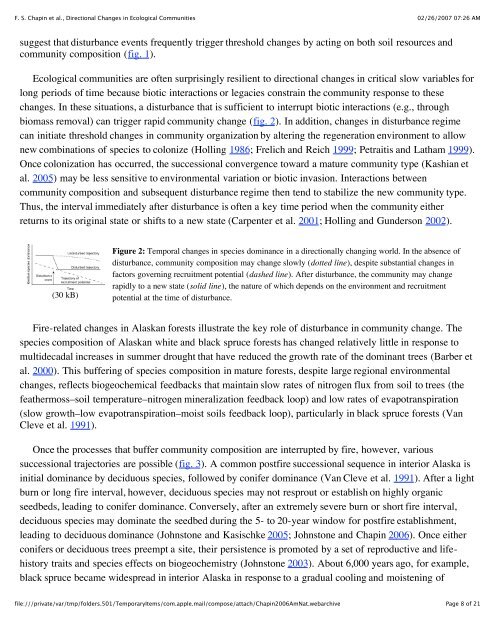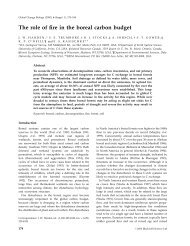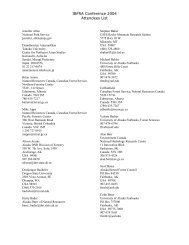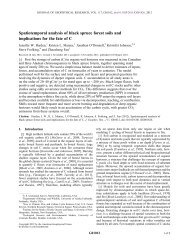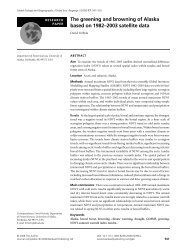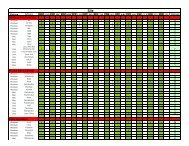Chapin, F.S., III, M.D. Robards, H.P. Huntington, J.F. Johnstone, S.F. ...
Chapin, F.S., III, M.D. Robards, H.P. Huntington, J.F. Johnstone, S.F. ...
Chapin, F.S., III, M.D. Robards, H.P. Huntington, J.F. Johnstone, S.F. ...
Create successful ePaper yourself
Turn your PDF publications into a flip-book with our unique Google optimized e-Paper software.
F. S. <strong>Chapin</strong> et al., Directional Changes in Ecological Communities<br />
02/26/2007 07:26 AM<br />
suggest that disturbance events frequently trigger threshold changes by acting on both soil resources and<br />
community composition (fig. 1).<br />
Ecological communities are often surprisingly resilient to directional changes in critical slow variables for<br />
long periods of time because biotic interactions or legacies constrain the community response to these<br />
changes. In these situations, a disturbance that is sufficient to interrupt biotic interactions (e.g., through<br />
biomass removal) can trigger rapid community change (fig. 2). In addition, changes in disturbance regime<br />
can initiate threshold changes in community organization by altering the regeneration environment to allow<br />
new combinations of species to colonize (Holling 1986; Frelich and Reich 1999; Petraitis and Latham 1999).<br />
Once colonization has occurred, the successional convergence toward a mature community type (Kashian et<br />
al. 2005) may be less sensitive to environmental variation or biotic invasion. Interactions between<br />
community composition and subsequent disturbance regime then tend to stabilize the new community type.<br />
Thus, the interval immediately after disturbance is often a key time period when the community either<br />
returns to its original state or shifts to a new state (Carpenter et al. 2001; Holling and Gunderson 2002).<br />
(30 kB)<br />
Figure 2: Temporal changes in species dominance in a directionally changing world. In the absence of<br />
disturbance, community composition may change slowly (dotted line), despite substantial changes in<br />
factors governing recruitment potential (dashed line). After disturbance, the community may change<br />
rapidly to a new state (solid line), the nature of which depends on the environment and recruitment<br />
potential at the time of disturbance.<br />
Fire-related changes in Alaskan forests illustrate the key role of disturbance in community change. The<br />
species composition of Alaskan white and black spruce forests has changed relatively little in response to<br />
multidecadal increases in summer drought that have reduced the growth rate of the dominant trees (Barber et<br />
al. 2000). This buffering of species composition in mature forests, despite large regional environmental<br />
changes, reflects biogeochemical feedbacks that maintain slow rates of nitrogen flux from soil to trees (the<br />
feathermoss–soil temperature–nitrogen mineralization feedback loop) and low rates of evapotranspiration<br />
(slow growth–low evapotranspiration–moist soils feedback loop), particularly in black spruce forests (Van<br />
Cleve et al. 1991).<br />
Once the processes that buffer community composition are interrupted by fire, however, various<br />
successional trajectories are possible (fig. 3). A common postfire successional sequence in interior Alaska is<br />
initial dominance by deciduous species, followed by conifer dominance (Van Cleve et al. 1991). After a light<br />
burn or long fire interval, however, deciduous species may not resprout or establish on highly organic<br />
seedbeds, leading to conifer dominance. Conversely, after an extremely severe burn or short fire interval,<br />
deciduous species may dominate the seedbed during the 5- to 20-year window for postfire establishment,<br />
leading to deciduous dominance (<strong>Johnstone</strong> and Kasischke 2005; <strong>Johnstone</strong> and <strong>Chapin</strong> 2006). Once either<br />
conifers or deciduous trees preempt a site, their persistence is promoted by a set of reproductive and lifehistory<br />
traits and species effects on biogeochemistry (<strong>Johnstone</strong> 2003). About 6,000 years ago, for example,<br />
black spruce became widespread in interior Alaska in response to a gradual cooling and moistening of<br />
file:///private/var/tmp/folders.501/TemporaryItems/com.apple.mail/compose/attach/<strong>Chapin</strong>2006AmNat.webarchive<br />
Page 8 of 21


